新编实用英语综合教程Unit 1
- 格式:doc
- 大小:72.50 KB
- 文档页数:5
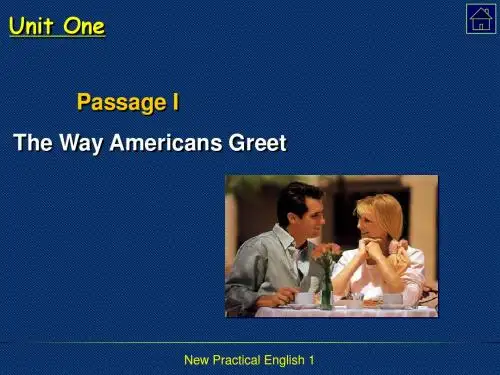
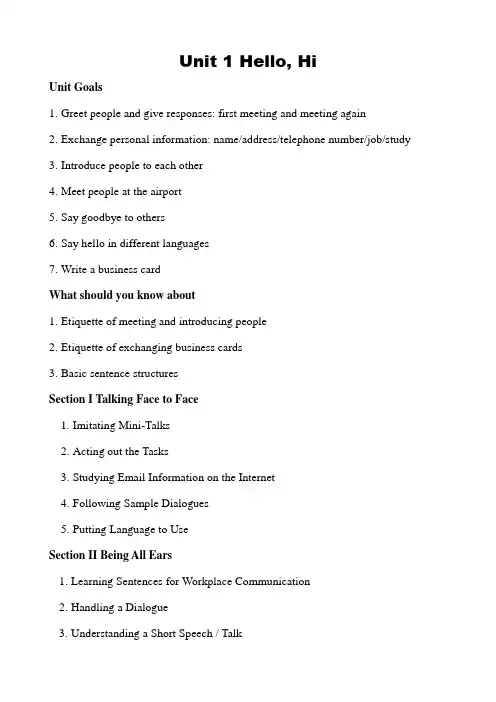
Unit 1 Hello, HiUnit Goals1.Greet people and give responses: first meeting and meeting again2.Exchange personal information: name/address/telephone number/job/study3.Introduce people to each other4.Meet people at the airport5.Say goodbye to others6.Say hello in different languages7.Write a business cardWhat should you know about1.Etiquette of meeting and introducing people2.Etiquette of exchanging business cards3.Basic sentence structuresSection I Talking Face to Face1.Imitating Mini-Talks2.Acting out the Tasks3.Studying Email Information on the Internet4.Following Sample Dialogues5.Putting Language to UseSection II Being All Ears1.Learning Sentences for Workplace Communication2.Handling a Dialogue3.Understanding a Short Speech / TalkSection III Trying your Hand1.Practicing Applied Writing2.Writing Sentences and Reviewing GrammarSection IV Maintaining a Sharp EyePassage 1 :Information Related to the Reading PassageEnglish Expressions Borrowed from FrenchOver the long years, the English language has borrowed a great number of French words or expressions. Some of them have been so absorbed in English that speakers might not realize their origin. Other expressions like “faux pas〞have retained their “Frenchness〞, with which speakers tend to sound modern. These expressions are often written in italics. The following are a few French expressions which are commonly used in English.1. Faux Pas: It refers to a socially awkward or tactless act, a foolish mistake, something that should not be done. 失礼2. au pair: A foreign female student who works for a family (cleaning and/or teaching the children) in exchange for room and board. 帮助料理家务换取住宿的外国女学生3. Bon appétit: The closest English equivalent is “Enjoy your meal〞. 用餐愉快4. esprit de corp s: It is similar to “group spirit〞or “morale〞. 团队精神5. rendez-vous: In English it means “go to〞. It can be used as a noun or a verb. 约会6. RSVP: This abbreviation stands for Répondez, s'il vous plaît, which means“Respond, please〞.敬请回复7. bon voyage: a way of saying goodbye and wishing good luck 一路平安The Business Card: a Social Faux PasYou, like most people, probably have been in such a situation where you are being asked for a business card, and while reaching for it ... and ... oops ... “I'm sorry, I must be out at the moment〞or “they must be in my other bag〞or “I left them at the office, I'm sorry,〞and the conversation continues on with some sort of story about how this “never happens to me〞or “I knew I was forgetting something this morning ...〞Missed connections are missed opportunities for business. Business cards are a useful marketing tool, and an easy one to have with you at all times. Not having your cards can be seen as being unprepared to market yourself and your business. Don't start t hat new contact leaving them thinking “that person is already unprepared〞.“Never leave home without it ...〞There are so many things we often have to remember in this go-go world we are living in … but your business cards should ALWAYS be with you.Here are a few tips for you to go take care of this right now, so youdon't get caught in this situation:✧ If you don't have a job, get Networking Cards.✧ If you are employed, and haven't had new cards in 2 or more years,it couldbe time for an update: info update and photo update ...✧ Perhaps set a goal of handing out 5 cards a day.✧ Practice what you will say when handing them out. On a daily basis, there are so many opportunities to do so. Grocery store lines, coffee shops, waiting on your car wash, meetings, and even the dog park!✧ Ask your network to network with and for you also by handing out a few!Work smarter, not necessarily harder!Language Points1 Explanation of Difficult Sentences1. (Para. 2) Missed connections are missed opportunities for business.Analysis: Missed is a verb's past participle used here as an adjective.The repeated use of the same word could bring out a stronger effect. Translation: 错失了联络就错失了商机。
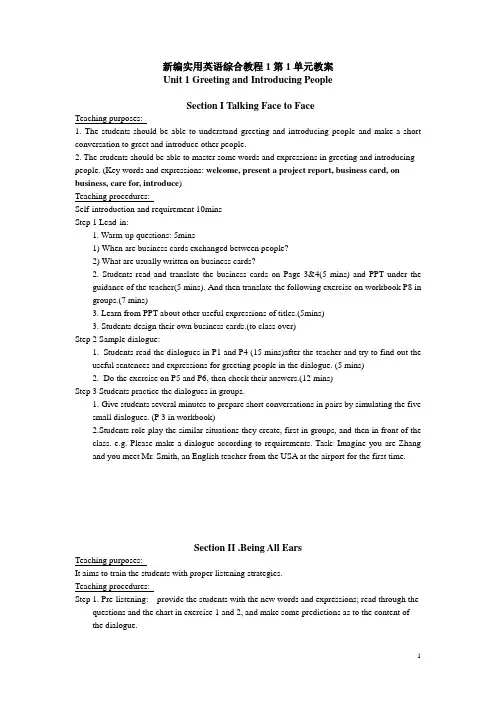
新编实用英语综合教程1第1单元教案Unit 1 Greeting and Introducing PeopleSection I Talking Face to FaceTeaching purposes:1. The students should be able to understand greeting and introducing people and make a short conversation to greet and introduce other people.2. The students should be able to master some words and expressions in greeting and introducing people. (Key words and expressions: welcome, present a project report, business card, on business, care for, introduce)Teaching procedures:Self-introduction and requirement 10minsStep 1 Lead-in:1. Warm-up questions: 5mins1) When are business cards exchanged between people?2) What are usually written on business cards?2. Students read and translate the business cards on Page 3&4(5 mins) and PPT under theguidance of the teacher(5 mins). And then translate the following exercise on workbook P8 in groups.(7 mins)3. Learn from PPT about other useful expressions of titles.(5mins)3. Students design their own business cards.(to class over)Step 2 Sample dialogue:1. Students read the dialogues in P1 and P4 (15 mins)after the teacher and try to find out theuseful sentences and expressions for greeting people in the dialogue. (5 mins)2. Do the exercise on P5 and P6, then check their answers.(12 mins)Step 3 Students practice the dialogues in groups.1.Give students several minutes to prepare short conversations in pairs by simulating the fivesmall dialogues. (P 3 in workbook)2.Students role-play the similar situations they create, first in groups, and then in front of theclass. e.g. Please make a dialogue according to requirements. Task: Imagine you are Zhang and you meet Mr. Smith, an English teacher from the USA at the airport for the first time.Section II .Being All EarsTeaching purposes:It aims to train the students with proper listening strategies.Teaching procedures:Step 1. Pre-listening: provide the students with the new words and expressions; read through the questions and the chart in exercise 1 and 2, and make some predictions as to the content of the dialogue.(Key words and expressions:1.Canada/The United States (of America) / the United Kingdom (of Great Britain andNorthern Ireland); England--Scotland--Welsh--Northern Ireland ;Britain;2.College3.Surprise surprise partyHis visit gave me a pleasant surprise. 他的来访使我感到惊喜。
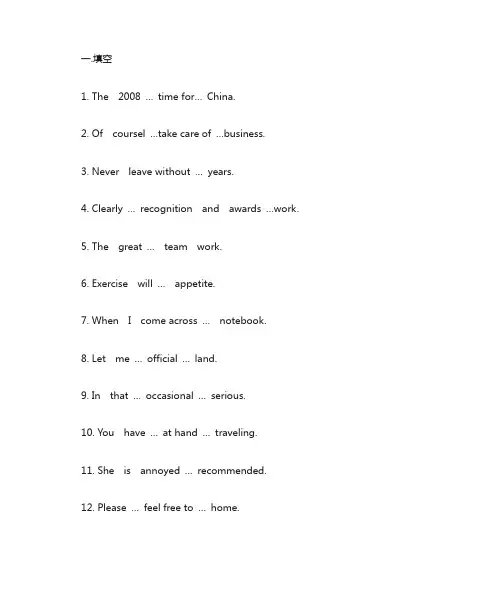
一.填空1. The 2008 …time for…China.2. Of coursel …take care of …business.3. Never leave without …years.4. Clearly …recognition and awards …work.5. The great …team work.6. Exercise will …appetite.7. When I come across …notebook.8. Let me …official …land.9. In that …occasional …serious.10. You have …at hand …traveling.11. She is annoyed …recommended.12. Please …feel free to …home.13. `Nowadays …assume that …is celebrated …America.14. Is Spring Festival a …the majority …countries?15. My family …end-of-year cleaning.16. Some universities …Muslim(s) …food.17. Decorating the …colorful candles …now.18.In the 1950s …large choice …them.19.Do you …ways of thinking?20.The Asian …festive event …People shared …athletes.二,汉译英。
1.像…自己。
You, like most people, probably are learning how to market yourself.2.对不起…走!I’m so sorry , My go-go boss asks me to leave right now.3.我…言表。
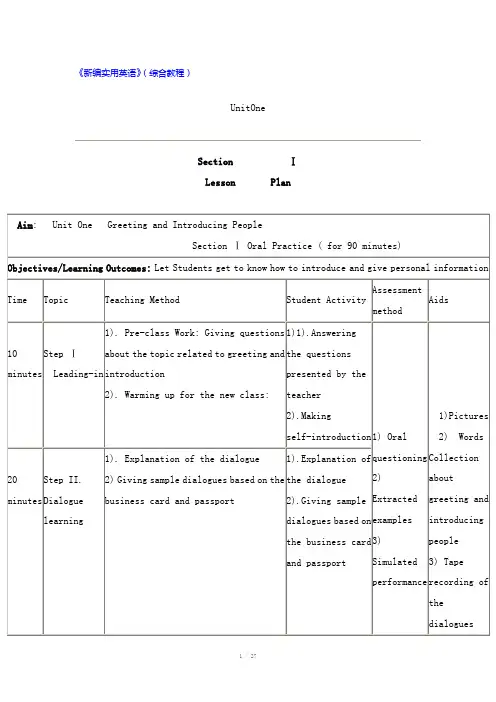
《新编实用英语》(综合教程)UnitOneSection ⅠLesson PlanContent: Section ⅠTalking face to faceAim: The topic area of Taking Face to Face in this unit is to talk about greeting people and introducing with each other. The focus of functions is to Let Students get to know how to introduce and give personal informationImportant and difficult points:Procedure and methods:Step I. Leading-in1. Pre-class Work: Giving questions about the topic related to greeting and introduction2. Warming up for the new class3. Student Activity:1).Answering the questions presented by the teacher2). Making self-introductionStep II. Dialogue learning1. Explanation of the dialogue2. Giving sample dialogues based on the business card and passport3. Student Activity:1). Listening to the tape recording of the dialogues2).Pair work: Learning the dialogues by heart and Reading out the dialogues loudly in pairs.Step Ⅲ Acting outAfter learning the five dialogues on the book1 Dividing the students into groups of four or five2 Offering more situations for students to make dialogue3 Summarizing this part4 Student Activities:1).Group discussion: Following the dialogue and making dialogues based on the given situations2). Comments on classmates’ performanceStepⅣ Putting in use1. Completing and checkingInstructions: Ask students to work in groups to complete by filling in the blanks on Page 4, and then check the answers in class.2. RespondingInstructions:Ask students to practice Exercise 2 on Page 4 of the textbook orally . Offer the situation in Chinese, and ask students to give the English version, the whole class works together. After each activity, check the answers and make comments promptly.Section ⅡLesson planContent: Section Ⅱ Being All EarsAim: Make the students master more useful vocabulary phrases and sentences to express themselves in English .when they meet people and introduce with each other.Important and difficult points:1. Introduction:Listening comprehension is the receptive skill in the oral mode. When we speak of listening what we really mean is listening and understanding what we hear.In our first language, we have all the skills and background knowledge we need to understand what we hear, so we probably aren't even aware of how complex a process it is. Here we will briefly describe some of what is involved in learning tounderstand what we hear in a second language.2.Listening Situations:There are two kinds of listening situations in which we find ourselves:·Interactive·non-interactive.Interactive listening situations include face-to-face conversations and telephone calls, in which we are alternately listening and speaking, and in which we have a chance to ask for clarification, repetition, or slower speech from our conversation partner. Some non-interactive listening situations are listening to the radio, TV, films, lectures, or sermons. In such situations we usually don't have the opportunity to ask for clarification, slower speech or repetition.Listen for main ideas. The main ideas are the most important points the speaker wants to get across. They may be mentioned at the start or end of a talk, and repeated a number of times. Pay special attention to statements that begin with phrases such as "My point is..." or "The thing to remember is..."Give your full attention on the person who is speaking. Don't look out the window or at what else is going on in the room.Remember: time is on your side! Thoughts move about four times as fast as speech. With practice, while you are Listening you will also be able to think about what you are hearing, really understand it.Procedure and methods:Step Ⅰ Listen and decode & Listen and respond1. Introduction of some listening skillsInstructions:Help students get to know how to distinguish sound-similar words.2. Explanation of the dialogue and commentsInstructions: In this part students must choose out the words they hear from the tape recording. After playing the tape twice, check their answers.3. RespondingInstructions: After listening to the tape for the third time, students are asked to answer the questions listed out in the textbook orally. Step II. Listen and complete & Listen and judge1. Completing after listeningInstructions: Ask students to fill in the blanks with the words they get from the tape recording after hearing it for twice.2. Judging after listeningInstructions: After students listen to the same dialogue for the third time, ask them to choose the correct answers to the given sentence. Step Ⅲ.Listen and read, Listen and match1. Explanation of the key wordsInstructions: Students are going to hear a passage with some blanks for them to fill in. Before playing the tape recording, explain some key words which will appear in it. Ask students to memorize these words.2. Explanation of the listening materialInstructions: After students finish the filling-in, explain some difficult language points in the passage.3. Matching after listeningInstructions:In this part a dialogue will be given to each of the students, after they listen to it, they are asked to match the information in ColumnA with the choices in Column B. Then check their answers.4. Answering questions after listening to the passage again.Instructions:In this part the students are asked to write out the general idea of the passage in one paragraph by answering some listed questions in the textbook.Step Ⅳ. Listen and conclude1. Exercises in the workbookInstructions: Give explanations to some new words in the workbook, and ask students to finish the exercises in it, then check their answers. Asking students to memorize the new words which appear in the textbookSection ⅢLesson Plan。


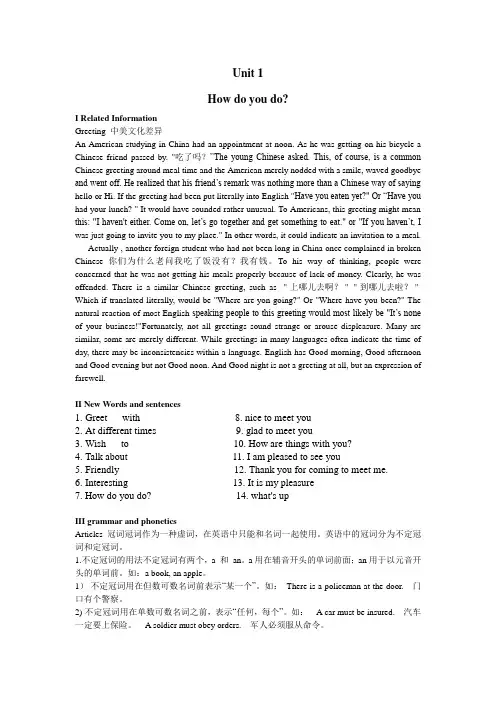
Unit 1How do you do?I Related InformationGreeting 中美文化差异An American studying in China had an appointment at noon. As he was getting on his bicycle a Chinese friend passed by. "吃了吗?”The young Chinese asked. This, of course, is a common Chinese greeting around meal time and the American merely nodded with a smile, waved goodbye and went off. He realized that his friend’s remark was nothing more than a Chinese way of saying hello or Hi. If the greeting had been put literally into English "Have you eaten yet?" Or “Have you had your lunch? " It would have sounded rather unusual. To Americans, this greeting might mean this: "I haven't either. Come on, let’s go together and get something to eat." or "If you haven’t, I was just going to invite you to my place." In other words, it could indicate an invitation to a meal.Actually , another foreign student who had not been long in China once complained in broken Chinese 你们为什么老问我吃了饭没有?我有钱。
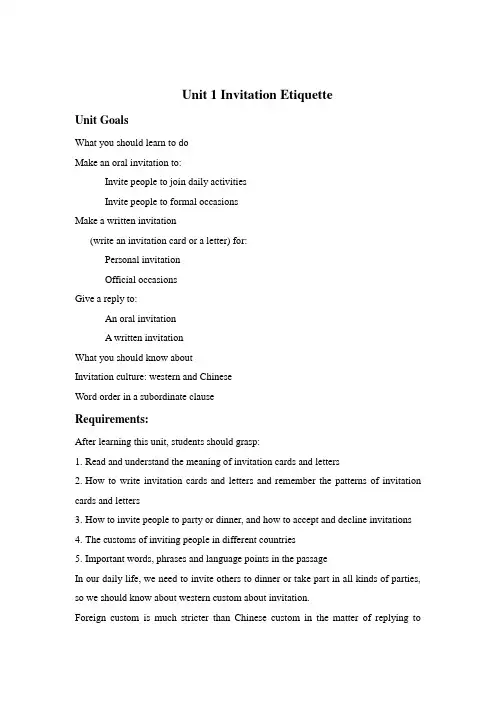
Unit 1 Invitation EtiquetteUnit GoalsWhat you should learn to doMake an oral invitation to:Invite people to join daily activitiesInvite people to formal occasionsMake a written invitation(write an invitation card or a letter) for:Personal invitationOfficial occasionsGive a reply to:An oral invitationA written invitationWhat you should know aboutInvitation culture: western and ChineseWord order in a subordinate clauseRequirements:After learning this unit, students should grasp:1.Read and understand the meaning of invitation cards and letters2.How to write invitation cards and letters and remember the patterns of invitation cards and letters3.How to invite people to party or dinner, and how to accept and decline invitations4.The customs of inviting people in different countries5.Important words, phrases and language points in the passageIn our daily life, we need to invite others to dinner or take part in all kinds of parties, so we should know about western custom about invitation.Foreign custom is much stricter than Chinese custom in the matter of replying toinvitations. When you receive an invitation you should answer is immediately, saying definitely whether you are able to accept it or not.If the invitation is given by word of mouth, in conversation or at a chance meeting, you should answer at once whether you can come or not. If you cannot give an answer at that time, you may say “May I let you know this evening” or some such words.By studying this unit, we will know about how to invite the others, how to accept or decline the invitation, and how to write invitation cards/letters.Section I Talking Face to Face1.Imitating Mini-Talks2.Acting out the Tasks3.Studying Email Information on the Internet4.Following Sample Dialogues5.Putting Language to UseSection II Being All Ears1.Learning Sentences for Workplace Communication2.Handling a Dialogue3.Understanding a Short Speech / TalkSection III Trying your Hand1.Practicing Applied Writing2.Writing Sentences and Reviewing GrammarSection IV Maintaining a Sharp EyePassage 1 :Information Related to the Reading PassageWhether it is to a wedding, a dinner party, shower or gala event, an invitation comes with some important obligations. Here’s a quick guide to keep you on the guest list.1. R.S.V.PFrom the French “Répondez, s’il vous plait”, it means “Please reply.”Thislittle code has been around for a long time and it’s definitely telling you that your hosts want to know if you are attending. Reply promptly, within a day or two of receiving an invitation.2. How do I respond? Reply in the manner indicated on the invitation.R.S.V.P and no response card: a handwritten response to the host at the return address on the envelope.Response Card: fill in and reply by the date indicated and return in the enclosed envelope.R.S.V.P with phone number: telephone and make sure to speak in person —answering machines can be unreliable.R.S.V.P with e-mail: you may accept or decline electronically.Regrets only: reply only if you cannot attend. If your host doesn’t hear from you, he is expecting you!No reply requested? Unusual, but it is always polite to let someone know your intentions. A phone call would be sufficient.3. Is that your final answer?Changing a “yes”to a “no”is only acceptable on account of: illness or injury, a death in the family or an unavoidable professional or business conflict. Call your hosts immediately.Canceling because you have a “better”offer is a surefire way to get dropped from ALL the guest lists.Being a “no show”is unacceptable.Changing a “no”to a “yes”is OK only if it will not upset the hosts’arrangements.4. “May I bring …?”Don’t even ask! An invitation is extended to the people the hosts want to invite —and no one else.…a date. Some invitations indicate that you may invite a guest or date (Mr. JohnEvans and Guest) and when you reply, you should indicate whether you are bringing someone, and convey their name.…my children. If they were invited, the invitation would have said so.…my houseguest. It’s best to decline the invitation, stating the reason. This gives your host the option to extend the invitation to your guests, or not.5. Say “Thank You.”Make sure to thank your hosts before you leave, and then again by phoneor note the next day.Text Business InvitationA case of mistaken identity!Don’t worry, we’ve been assured that this mystery will besolved in time for ourHoliday Office PartyWe’re leaving the investigation to those who do it best.Let’s get away from all those computers, papers and mess and cometo our office party in your best suit or dress.Come join us and Toast the SeasonThursday, December 9th 2010 5:00 P.M.The Columbia House –Penthouse Floor 485 Jefferson PlazaLeonard, Barley, Travis, Bailey and SmithRegrets only to Dianne 248-8522It would be a crime to miss our party or not be on time485 Jefferson PlazaBusiness invitations can be informal or formal. Although invitations are usually sent through the mail, informal invitations such as e-mail and phone invitations are becoming more acceptable.Invitation TimingFor most formal occasions, it’s best to invite guests three or four weeks inadvance. If you choose to invite your guests by phone, remind them again in writing two weeks before the gathering. Here are a few guidelines for your information:●Six to eight months before an important seminar to which out-of-town executives are invited.●Four weeks before an evening reception.●Two to four weeks before a cocktail party.Invitation FormatFormal business invitations are most commonly printed on white or off-white high-quality paper. A company can use any color of paper it desires, as long as it upholds and promotes the company’s image.With preprinted invitations, you simply fill in the blanks to tell what, where, and when the party will be and who is giving it. It’s also acceptable to include an RSVP notation and your phone number or address on the invitation for more accurate planning.Responding to an InvitationEither use the address or phone number printed in the lower left corner of the invitation or return the RSVP card sent with the invitation. If a “Please reply by”a given date is included in the invitation, be polite enough to reply by that date. If the words “Regrets only”are printed in the lower left corner of the invitation, you need only to inform the host if you will not be able to attend. If your host does not hear from you, you are expected to attend.Never ask to bring a guest unless the invitation states “Mr. Louis Winthorp and Guest.”Most likely, the host will have only enough food and drinks for the number of people he invites. Showing up with an uninvited friend could turn out to be an embarrassing situation for everyone.Language Points1 Explanation of Difficult Sentences1. (Para. 1) Although invitations are usually sent through the mail, informalinvitations such as e-mails and phone invitations are becoming more acceptable. Analysis: such as means “of the same kind, like”and should be followed by nouns or noun phrases.Translation: 虽然邀请函通常通过信函方式发出,但目前像电子邮件、电话邀请等非正式邀请越来越被普遍使用。
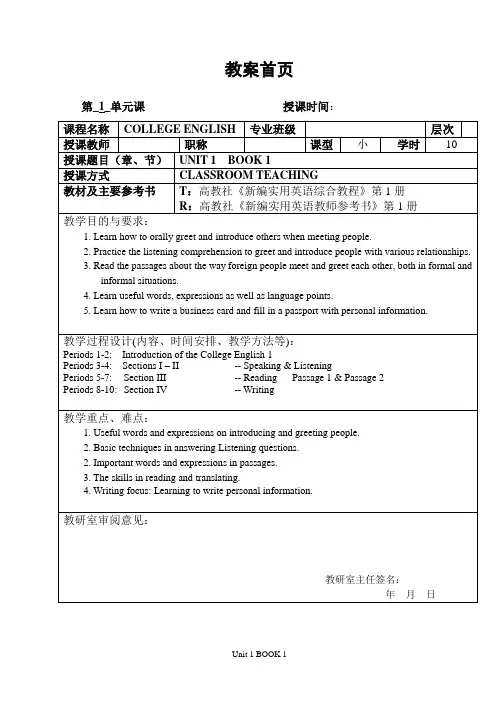
1
Unit 1 Hello, Hi!
一、本课及各部分的教学目的及重点
教
学
目
的
及
重
点
难
点
目 的 重 点
Lead-in
通过讲、学、练、查,
使学生学会初次见面时
自我介绍及问候对方的
常用表达方式
介绍相关信息
Section I
Talking face to face
能够在与人会面时进行简单的寒暄和交流 寒暄语、会面交流和交换
名片
Section II
Grammatical Item –
Sentence Structures
掌握单句的几种常见结构,能识别句子成分 基本句型结构;定语;状
语;there be 句式
Section III
Maintaining a Sharp Eye
熟悉文章结构和内容,掌握重点词汇和句型 文章中的单词、短语和句
子
Section IV
Living in Tianjin
能用英文简单表达天津
的历史由来、地理位置
和气候
文章中的单词、短语和句
子
Section V
Writing – Business
Cards
能够独立规范制作名片
掌握名片的格式、内容和
常见英文表达
二、具体教学过程
Section Ⅰ Talking face to face (Room Reservation)
Useful Sentences
2
A. Sentence Patterns B. Translation
1. Hello, nice to meet you.
2. How do you do.
3. Here’s my (business) card.
4. Please call me Jack.
5. I’m Jack from Zhonghua Technical
School.
6. Welcome to our company.
7. Long time no see.
8. How’s going recently?
9. It’s a small world.
10. Haven’t seen you for ages.
11. How’s everything?
12. What brings you here?
13. I’m here on business.
1. 你好,很高兴见到你。
2. 你好。
3. 这是我的名片。
4. 请叫我杰克。
5. 我是来自中华技术学校的杰克。
6. 欢迎您来到我们公司。
7. 好久不见。
8. 最近过得怎样?
9. 这个世界真小。
10. 好久不见。
11. 一切都好吗?
12. 哪股风把你给吹来了?
13. 我是来这里出差的。
(该环节首先播放教学视频,使学生对寒暄和交流过程有直接的认识。然后教师将见面
寒暄和交流的相关表达进行讲解后,学生自由模拟训练为主,重在帮助学生循序渐进地
从单个句型到连贯对话进行过渡。此时,教师不用对学生要求过高,可以先从模仿练起,
鼓励学生举一反三。)
Section II Grammatical Item – Sentence Structures(句子结构)
1.基本句型结构:(主+谓)结构、(主+谓+宾)结构、(主+谓+宾+宾补)结构、(主+
系+表)结构
(1)(主+谓)结构
主谓结构的句子的谓语动词是不及物动词,后面不接宾语。
3
The sun rises. 太阳升起来了。
He died. 他死了。
She smiled. 她笑了。
(2)(主+谓+宾)结构
主谓宾结构的谓语动词多数为及物动词,如果是不及物动词,需先加个介词,然后
才可接宾语。
I love my hometown. 我爱我的家乡。(及物动词)
I dislike traveling. 我不喜欢旅游。(及物动词)
He is waiting for her. 他在等她。(wait是不及物动词,后接for)
(3)(主+谓+宾+宾)结构
My father sent me a new bike as my birthday present. 我的爸爸送了我一辆新自行车
作为生日礼物。(me作间接宾语,bike作直接宾语)
(4)(主+谓+宾+宾补)结构
His words made me moved. 他的话叫我感动。(过去分词作宾补)
I find the novel very interesting. 我发现这部小说很有趣。(现在分词作宾补)
My manager asks me to do the work. 我的经理叫我做这项工作。(动词不定式作宾
补)
(5)(主+系+表)结构
It is cold today. 今天冷。(形容词作表语)
He looks pale. 他看上去脸色苍白。(形容词作表语)
It is necessary to prepare for tomorrow’s speech. 为明天的演讲做真准备是必要的。
(形容词作表语;动词不定式短语作形式主语)
4
2.定语
作定语的词有名词、动名词、代词、形容词(包括现在分词和过去分词)、数词等。
定语分为前置定语和后置定语。
Our class team won the game. 我们班队赢得了这场比赛。(代词作定语)
It’s a monthly magazine. 这是一本月刊杂志。(形容词作定语)
He is a taxi driver. 他是一个出租车司机。(名词作定语)
My first year in New York was very difficult. 我在纽约生活的第一年很困难。(数词作
定语)
American campers usually sleep in sleeping bags. 美国的野营者总是睡在睡袋里。(动
名词作定语)
The sleeping dog was woken up by the noise. 熟睡的小狗被噪音吵醒。(现在分词作
定语)
People there are very friendly. 那里的人们很亲切。(副词作后置定语)
3.状语
作状语的词有名词、形容词或形容词短语、副词等。
I have to ask for a one-day leave tomorrow. 明天我得请一天假。(名词作状语)
He approached us, full of apologies. 他连声道歉地朝我们走来。(形容词短语作伴随状
语)
The train runs very fast. 这列车跑得非常快。(副词作状语,fast作为副词修饰runs,
very 作为副词修饰fast)
4. There be 句式
There are a lot of people in the hall. 大厅里有很多人。
5
练习:完成课本P12的第5、6、7题。
Section III Maintaining a Sharp Eye
Section IV Living in Tianjin
Section IV Writing – Business Cards
一、格式(见课本P9)
二、内容
公司名称/部门名称,姓名/职务或职称,地址/邮编,电话,传真,电子邮件
三、练习:完成课本P10页练习。
Homework
1. 根据所学常用句型和语句,编一个客房预订的对话,要有完整的工作环节和创新的
情节。
2. 制作一张自己的名片,可以虚拟公司名称、部门和职称等。